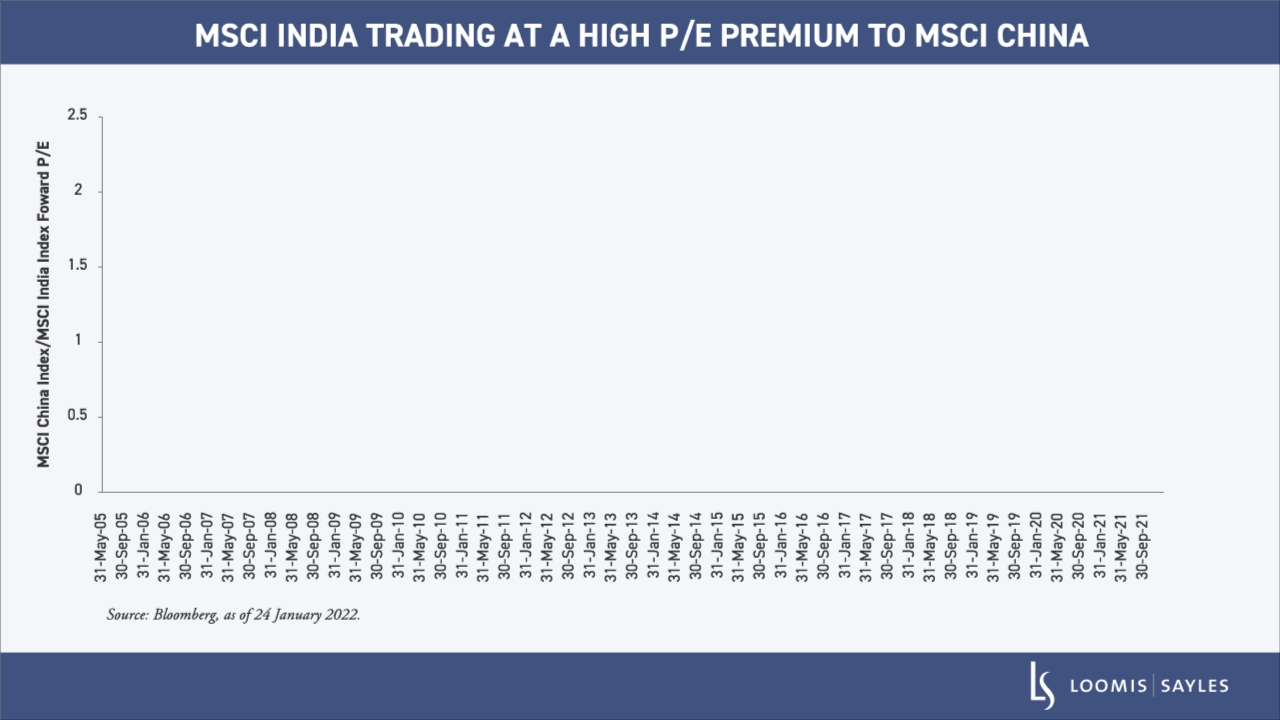1. With US rates expected to rise later this year, are you worried about the prospects for emerging market (EM) equities?
In our view, some investors have a misperception that higher US rates are bad for EM equities. If the Federal Reserve begins a hiking cycle, we would not anticipate much negative fallout for EM economies. In fact, we believe EM macro fundamentals are currently quite healthy and external vulnerabilities appear low. While inflation has picked up sharply in EMEA[i] and Latin America, it has forced central banks in these regions to start hiking rates well ahead of the Fed. China, on the other hand, has experienced subdued inflation and is currently easing monetary policy, with more pro-growth fiscal and monetary policies likely to come in 2022. We believe the Chinese economy could start to see sequentially rising growth from 4Q 2021 to 4Q 2022. The renminbi has been strong due to high current account surpluses, which should give the People’s Bank of China more room to ease. Furthermore, US dollar-denominated debt woes in China’s property sector has not spread contagion to other sectors. Outside the property sector, China has little exposure to unhedged US-dollar debt. India and Indonesia have improved their balance of payments and the World Bank has projected that these economies will be among the fastest growing in 2022. In addition, some EM countries, such as Korea and Taiwan, are typically more sensitive to global growth than rates.
We have a positive view of the ASEAN[ii] region, which was severely hit during the last US tightening cycle. Many of these economies may be on the cusp of a positive credit cycle due to structural space for leverage that could help drive GDP growth. Vaccination rates have increased significantly over the past few months, and 50% to 75% of the populations in many of these countries are now fully vaccinated. Inflation in ASEAN has been much lower than in the US and Europe due to excess capacity and a net benefit from supply chain disruptions. Global semiconductor shortages have benefited chipmakers in Korea, Taiwan and Malaysia. In our view, the US-China tech war should continue to drive chip manufacturing and assembly out of China and into ASEAN. We believe rising prices of commodities like coal, palm oil and natural gas will continue to benefit Indonesia and Malaysia, while commodity importers like India and the Philippines should withstand higher prices due to high foreign exchange reserves and strong external accounts. Valuations in many ASEAN equity markets appear inexpensive as we expect earnings to grow from a very low pandemic base. Many ASEAN currencies also appear cheap. In our view, inexpensive valuations, cheap currencies and low foreign debt and equity positioning (unlike the last US tightening cycle) should support ASEAN equity markets in 2022. Our biggest concern is a Fed policy mistake, particularly if the Fed becomes too aggressive in an environment when growth in the US might be slowing.
2. China’s growth slowed significantly last year as companies grappled with a regulatory crackdown. Do you see any potential opportunity among Chinese equities despite the headwinds?
We believe that in 2022, the Chinese equity market has the potential to stage a comeback. The deep, broad-based selloff in 2021 has resulted in low valuations (especially relative to other EM and developed markets) and inflation has been subdued. Government authorities have expressed a desire to boost economic growth and have seemingly pulled back on the regulatory crackdown. Given the ongoing slowdown, we believe that Beijing will inject additional monetary stimulus and accelerate infrastructure investment. Furthermore, last year, many global and EM investors sold Chinese equities and bought Indian equities. Indian equities were up 24.8% in 2021, compared to a 22.8% drop in Chinese equities.[iii] We believe these investors might rotate back into Chinese equities now that Indian equity valuations are beginning to look stretched, inflation has started to rise and the prospects of interest rate hikes in India have increased. We see potential opportunity in high- or transitioning-quality Chinese technology companies in structural growth industries that are aligned, and have benefited from, government policy.

3. How concerned are you about the impact of Russia/Ukraine tensions on Russian equities?
The situation between Russia and the Ukraine is extremely complex and we believe there is increased risk of further sanctions against Russia. In particular, Moscow’s desire to prevent Ukraine’s potential NATO[iv] membership directly contravenes the organization’s “open-door policy,” stipulated under Article 10 of its founding treaty. The US government appears interested in a diplomatic resolution to the growing crisis in Ukraine, but we believe there is no practical merit in debating a solution that violates the core principles of NATO. Given the US’ strong interest in protecting a free and democratic Ukraine, as well as Europe’s strategic dependence on Russia, we expect negotiations to continue. However, we anticipate the uncertainty and risk of escalation will weigh on markets in the interim. Russia has made significant progress in the last decade internalizing key industries and resources. Should the situation deteriorate, we believe the threat of sanctions is higher for specific Russian individuals, companies and sovereign debt rather than the broad Russian equity markets.
[i] Europe, Middle East and Africa
[ii] Association of Southeast Asian Nations
[iii] Source: Bloomberg, as of 31 December 2021.
[iv] North Atlantic Treaty Organization
MALR028507
Investment recommendations may be inconsistent with these opinions. There can be no assurance that developments will transpire as forecasted. Data and analysis does not represent the actual or expected future performance of any investment strategy, account or individual positions. Accuracy of data is not guaranteed but represents our best judgment and can be derived from a variety of sources.
Commodity, interest and derivative trading involves substantial risk of loss.
Past market experience is no guarantee of future results.
Market conditions are extremely fluid and change frequently.
Market conditions are extremely fluid and change frequently.
This blog post is provided for informational purposes only and should not be construed as investment advice. Any opinions or forecasts contained herein reflect the
subjective judgments and assumptions of the authors only and do not necessarily reflect the views of Loomis, Sayles & Company, L.P. Information, including
that obtained from outside sources, is believed to be correct, but Loomis Sayles cannot guarantee its accuracy. This material cannot be copied, reproduced or
redistributed without authorization. This information is subject to change at any time without notice.




